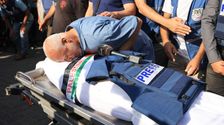It is the fifty-sixth day since the Hamas attack on October 7 that resulted in the deaths of about 1,200 Israelis. The ensuing Israeli onslaught has by now killed over 15,000 Palestinians, including over 6,000 children. A negotiated temporary ceasefire, with extensions, has seen the exchange of several hostages between Israel and Hamas, freeing the initially agreed 150 Palestinian prisoners in exchange for 50 Israeli captives, with a few extensions raising those figures to 180 Palestinians and 105 Israelis (and other nationalities). The Israeli bombings have now resumed, with Israel now urging residents in the south of the strip to evacuate (earlier, residents in the north were urged to evacuate south).
The mind is overwhelmed by the scale and the pace of the destruction in Gaza, the likes of which we have not witnessed at any point in recent memory. Many may justifiably be left wondering whether Israel has officially gone mad, or whether the indiscriminate devastation that is overwhelmingly slaughtering Palestinian civilians, by Israel’s own account, remains part of a calculated strategy. Paradoxically, the answer is yes to both: Israel has gone mad, and its madness is being rationally employed in the service of a well-worn military playbook. That playbook is called “the Dahiya Doctrine.”
Israel’s recent conduct in Gaza has remained consistent with the Dahiya Doctrine but is also taking it to the next level.
The Dahiya Doctrine was coined by current Minister Gadi Eisenkot when he was Chief of Northern Command in 2008. The military doctrine, named after the Dahiya quarter of Beirut that Israel targeted and leveled during the 2006 war, outlines “what will happen” to any enemy that dares attack Israel:
“What happened in the Dahiya quarter of Beirut in 2006 will happen in every village from which Israel is fired on,” Eisenkot declared in Israeli newspaper Yediot Aharonot in March 2008. “We will apply disproportionate force on [the village] and cause great damage and destruction there. From our standpoint, these are not civilian villages, they are military bases.”
The ‘mad dog’ and ‘master of the house gone mad’
Israel’s iconic late Defense Minister Moshe Dayan once said “Israel must be like a mad dog, too dangerous to bother.” Variations on this idea have been repeated by Israeli officials time and again. Former Defense Minister Pinhas Lavon, the initiator of the false-flag terror attack on Cairo in 1954, advocated “going crazy” if ever Israel were crossed. During the 2006 war with Lebanon, Prime Minister Ehud Olmert said Palestinians need to understand that “the master of the house has gone mad,” while promising “James Bond type operations, bim bam!”
After Israel’s 2008-9 Gaza onslaught, Operation Cast Lead, Israel’s Foreign Minister at the time, Tzipi Livni, stated that “our troops in the Gaza strip behaved like hooligans, which I demanded of them.” She also stated that Israel “is a country that when you fire on its citizens it responds by going wild — and this is a good thing.”
Olmert, who presided over Cast Lead as PM, said: “We’ve said that if there is rocket fire against the south of the country, there will be a severe and disproportionate Israeli response.”
And, of course, Olmert’s “master of the house” mantra was more widely echoed last year as the election slogan of the far-right Itamar Ben-Gvir, who is now the Minister of National Security in Netanyahu’s government.
Bombing Gaza into the ‘stone age’
In other words, the whole point of the Dahiya Doctrine is to be “disproportionate” in any Israeli response to resistance — to demonstrate a certain level of madness, not precision. This is why Benny Gantz, a centrist minister (like Eisenkot) who is now part of the new emergency government, boasted of returning Gaza to the “stone age” and pulverizing entire neighborhoods during the 2014 Gaza onslaught when he was army Chief of Staff, footage of which he featured during his 2019 election campaign.
This “methodical madness” has been central in Israeli thinking across the political spectrum throughout Israeli history and has now been translated into flattening entire civilian neighborhoods as a norm. As Gantz’s example shows, this practice also has political currency in Israel, and demonstrating how one has excelled in this deed can enhance chances of getting elected, even as a liberal centrist.
All of this occurred long before October 7 and the deterrence blow suffered by the Israeli army. If Gaza had already returned to the “stone age” before October 7, where did the supposed “human animals” of Hamas come from?
In a word, they came from a concentration camp — a term that even the Defense Minister’s advisor used years ago — from pulverized neighborhoods with obliterated families that people like Gantz so liberally decimated.
The next stage of the Dahiya doctrine
While the Dahiya doctrine informed collective punishment, it appears that the current Israeli response is the next stage. The numbers, the scale of destruction, the level of siege, they are all unfathomable. In the words of UN Relief Chief Martin Griffiths, “the worst ever,” and he witnessed the Khmer Rouge killings in Cambodia in his twenties.
In an interview on Democracy Now, Israeli journalist Yuval Abraham explained how interviews with various Israeli military sources have revealed a relaxing of Rules of Engagement even further in Gaza. Abraham outlines the concept of “power targets” in the Israeli military jargon. This strategy was developed in 2014 and involves targeting residential high-rise buildings. Although a military justification is given, Abraham’s military sources involved in these “power target” bombings tell him the real purpose of these bombings is to put pressure on Palestinians civilians, which would then translate to pressure on Hamas.
Abraham points out that in May 2021, Israel bombed the al-Jalaa 11-story tower, which included residential apartments, as well as the news offices of Al Jazeera and AP, as one of the nine high-rises bombed then — as “power targets.” But in 2023, this whole practice has been dramatically expanded. In the mere first five days of the 2023 onslaught following October 7, Israel targeted a whopping 1,329 targets, which were considered “power targets” by the military. And this time, these “power targets” were bombed without evacuation orders. Abraham says that in the past, at least in internal Israeli military protocol, “power targets” were only to be bombed after evacuation but that now this protocol is not being adhered to, so buildings collapse fully upon their residents. It would appear that the Dahiya Doctrine’s idea of regarding civilians as military targets has come to its most explicit genocidal fruition.
The Dahiya Doctrine is not a recent invention from the 2006 Lebanon War — it evolved from Israeli settler-colonial dehumanization of Palestinians. The doctrine formularized the indiscriminate and disproportionate attack on a civilian population and civilian institutions such as hospitals, and it became a standard. What we see is now the next stage of this murderous policy in practice.
At Mondoweiss, we understand the power of telling Palestinian stories. For 17 years, we have pushed back when the mainstream media published lies or echoed politicians’ hateful rhetoric. Now, Palestinian voices are more important than ever.
Our traffic has increased ten times since October 7, and we need your help to cover our increased expenses.
Related posts:
Views: 0
 RSS Feed
RSS Feed

















 December 2nd, 2023
December 2nd, 2023  Awake Goy
Awake Goy 






 Posted in
Posted in  Tags:
Tags: 
















